| Solar eclipse of April 7, 1940 | |
|---|---|
 Map | |
| Type of eclipse | |
| Nature | Annular |
| Gamma | 0.219 |
| Magnitude | 0.9394 |
| Maximum eclipse | |
| Duration | 450 sec (7 m 30 s) |
| Coordinates | 19°12′N 128°30′W / 19.2°N 128.5°W |
| Max. width of band | 230 km (140 mi) |
| Times (UTC) | |
| Greatest eclipse | 20:21:21 |
| References | |
| Saros | 128 (54 of 73) |
| Catalog # (SE5000) | 9375 |
An annular solar eclipse occurred on Sunday, April 7, 1940. A solar eclipse occurs when the Moon passes between Earth and the Sun, thereby totally or partly obscuring the image of the Sun for a viewer on Earth. An annular solar eclipse occurs when the Moon's apparent diameter is smaller than the Sun's, blocking most of the Sun's light and causing the Sun to look like an annulus (ring). An annular eclipse appears as a partial eclipse over a region of the Earth thousands of kilometres wide. Annularity was visible from Gilbert and Ellice Islands (the part now belonging to Kiribati), Mexico and the United States.
Related eclipses
Solar eclipses 1939–1942
This eclipse is a member of a semester series. An eclipse in a semester series of solar eclipses repeats approximately every 177 days and 4 hours (a semester) at alternating nodes of the Moon's orbit.[1]
| Solar eclipse series sets from 1939–1942 | ||||||
|---|---|---|---|---|---|---|
| Descending node | Ascending node | |||||
| Saros | Map | Saros | Map | |||
| 118 | April 19, 1939 Annular |
123 | October 12, 1939 Total | |||
| 128 | April 7, 1940 Annular |
133 | October 1, 1940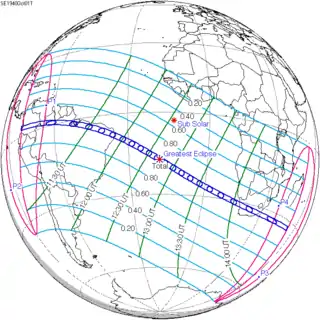 Total | |||
| 138 | March 27, 1941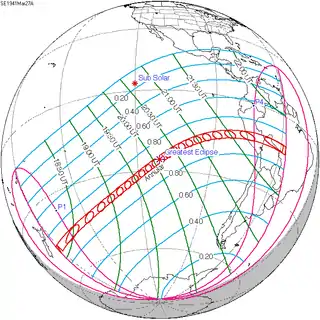 Annular |
143 | September 21, 1941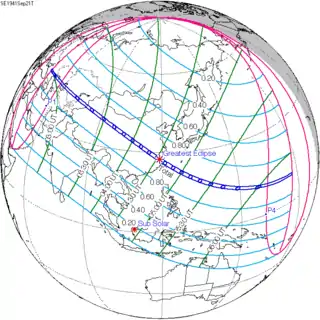 Total | |||
| 148 | March 16, 1942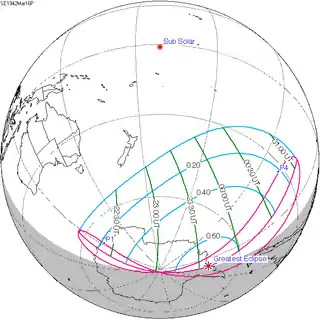 Partial |
153 | September 10, 1942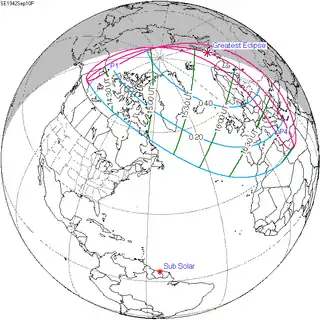 Partial | |||
| The partial solar eclipse on August 12, 1942 occurs in the next lunar year eclipse set. | ||||||
Saros 128
This eclipse is a member of the Solar Saros cycle 128, which includes 73 eclipses occurring in intervals of 18 years and 11 days. The series started with partial solar eclipse on August 29, 984 AD. From May 16, 1417 through June 18, 1471 the series produced total solar eclipses, followed by hybrid solar eclipses from June 28, 1489 through July 31, 1543, and annular solar eclipses from August 11, 1561 through July 25, 2120. The series ends at member 73 as a partial eclipse on November 1, 2282. All eclipses in this series occurs at the Moon’s descending node.
| Series members 52–68 occur between 1901 and 2200 | ||
|---|---|---|
| 52 | 53 | 54 |
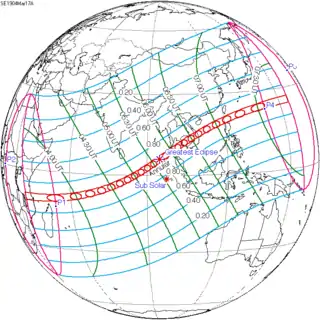 March 17, 1904 |
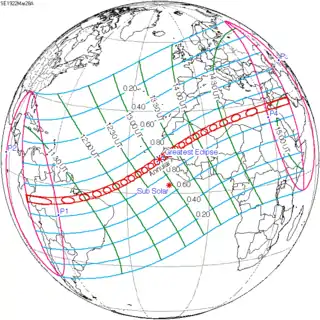 March 28, 1922 |
 April 7, 1940 |
| 55 | 56 | 57 |
 April 19, 1958 |
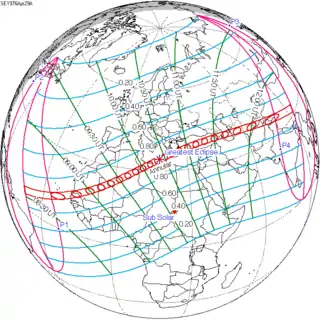 April 29, 1976 |
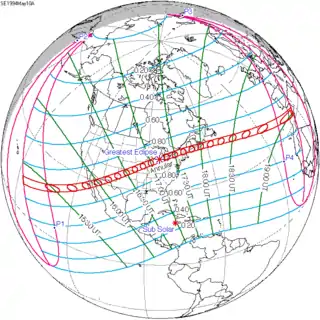 May 10, 1994 |
| 58 | 59 | 60 |
 May 20, 2012 |
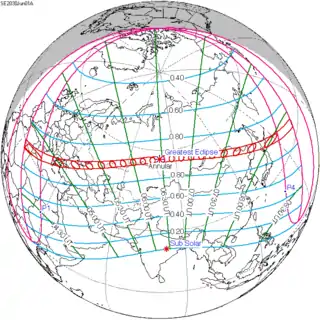 June 1, 2030 |
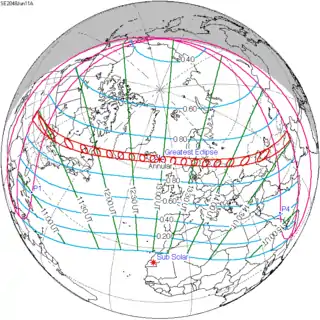 June 11, 2048 |
| 61 | 62 | 63 |
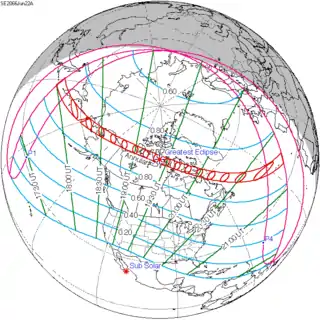 June 22, 2066 |
 July 3, 2084 |
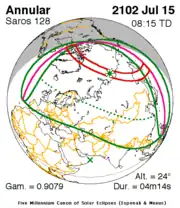 July 15, 2102 |
| 64 | 65 | 66 |
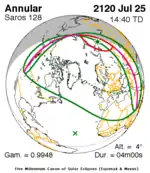 July 25, 2120 |
August 5, 2138 (Partial) | August 16, 2156 (Partial) |
| 67 | 68 | |
| August 27, 2174 (Partial) | September 6, 2192 (Partial) | |
Metonic series
The metonic series repeats eclipses every 19 years (6939.69 days), lasting about 5 cycles. Eclipses occur in nearly the same calendar date. In addition, the octon subseries repeats 1/5 of that or every 3.8 years (1387.94 days).
| 22 eclipse events, progressing from north to south between April 8, 1902, and August 31, 1989: | ||||
|---|---|---|---|---|
| April 7–8 | January 24–25 | November 12 | August 31-September 1 | June 19–20 |
| 108 | 114 | 116 | ||
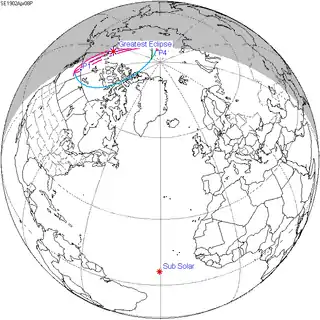 April 8, 1902 |
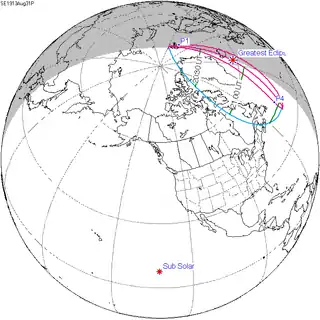 August 31, 1913 |
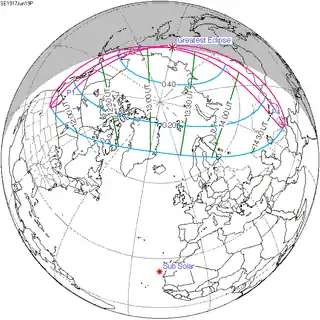 June 19, 1917 | ||
| 118 | 120 | 122 | 124 | 126 |
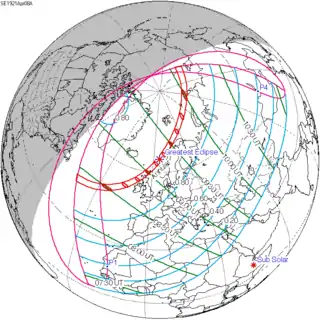 April 8, 1921 |
 January 24, 1925 |
 November 12, 1928 |
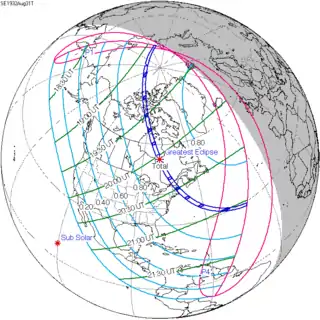 August 31, 1932 |
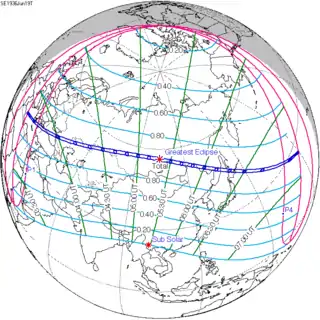 June 19, 1936 |
| 128 | 130 | 132 | 134 | 136 |
 April 7, 1940 |
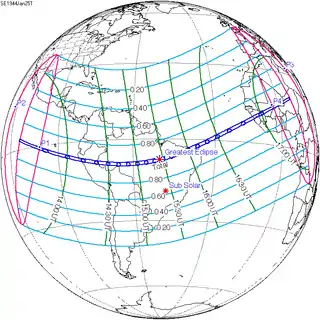 January 25, 1944 |
 November 12, 1947 |
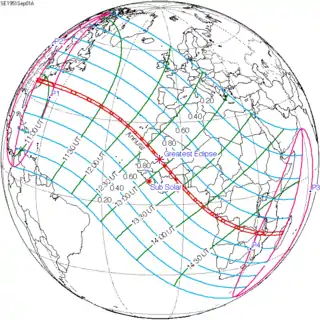 September 1, 1951 |
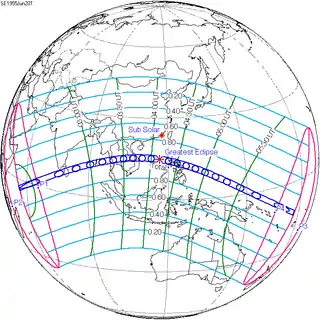 June 20, 1955 |
| 138 | 140 | 142 | 144 | 146 |
 April 8, 1959 |
 January 25, 1963 |
 November 12, 1966 |
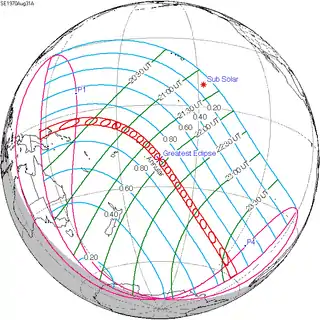 August 31, 1970 |
 June 20, 1974 |
| 148 | 150 | 152 | 154 | |
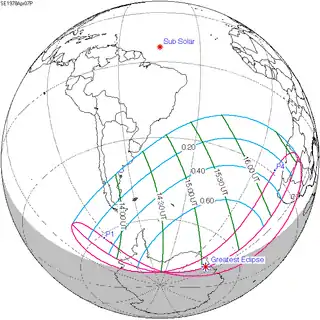 April 7, 1978 |
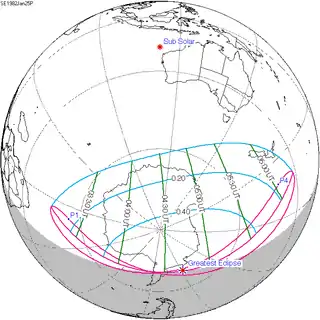 January 25, 1982 |
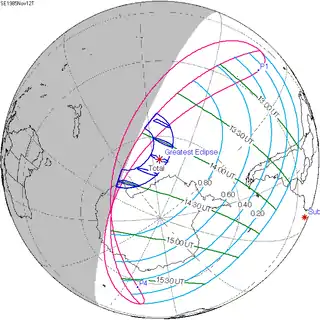 November 12, 1985 |
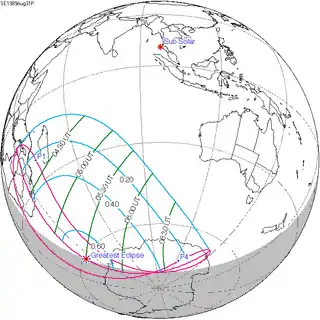 August 31, 1989 | |
Notes
- ↑ van Gent, R.H. "Solar- and Lunar-Eclipse Predictions from Antiquity to the Present". A Catalogue of Eclipse Cycles. Utrecht University. Retrieved 6 October 2018.
References
- Earth visibility chart and eclipse statistics Eclipse Predictions by Fred Espenak, NASA/GSFC
.jpg.webp)

